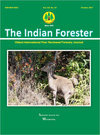Use of Common Langurs (Semnopithecus spp.) as Guard Animals in India: Some Legal and Practical Aspects
DOI:
https://doi.org/10.36808/if/2017/v143i10/119354Keywords:
Human-macaque Conflict, Guard Animals, Common Langur, Semnopithecus, Animal Welfare, Wildlife (Protection) Act, 1972, Prevention of Cruelty to Animals Act, 1960.Abstract
The Human-Macaque Conflict has become a serious issue in many parts of India. The State Forest Departments are hardpressed to find suitable and effective measures for mitigating this conflict. Use of common langurs (Semnopithecus spp.) as guard animals for scaring away troublesome macaques has evolved entirely through people's initiative to solve their own problems. Usefulness of the guard langurs is borne out by their large-scale deployment in the country. However, this practice has given rise to illegal capture and trade of common langurs. The animal right activists have also raised concerns about the welfare of the guard langurs. The advisory issued by the Wildlife Crime Control Bureau in October 2012 prohibiting the use of common langurs as guard animals has put the conflict-managers at a great disadvantage. The advisory is being violated even by the authorities at the highest levels. It has neither helped in ensuring welfare of the captive langurs nor in better compliance with the existing laws. A more pragmatic approach will be to regulate use of the guard langurs rather than ban it. This paper proposes a strategy for managing the Human-Macaque Conflict using the guard langurs in conformity with the provisions of the Wildlife (Protection) Act, 1972 and the Prevention of Cruelty to Animals Act, 1960 without compromising with the conservation status of the species in the wild.References
Agoramoorthy G. (2013). Grey Langur Semnopithecusentellus. In:Mammals of South Asia (Volume-I) (AJT John singh and N. Manjrekar, Eds), University Press, Hyderabad, 211-235 pp.
Anon (2007). The Wildlife (Protection) Act, 1972 (As amended up to 2006). Natraj Publishers, Dehradun.
Bist S.S. (1999). A critical review of the schedules of the Wildlife (Protection) Act, 1972 and their amendments. Indian Forester, 125(10):943- 962.
Fooden J. (2000).Systematic review of the rhesus macaque Macaca mulatta (Zimmermann, 1780). Fieldiana Zoologica, 96: 1–180.
GOI (1960): Prevention of Cruelty to Animals Act, 1960.http://awbi.org/?q=node/7 (accessed on 26.10.2016).
GOI (1978): Transport of Animals Rules, 1978.http://awbi.org/?q=node/7 (accessed on26.10.2016).
GOI (1979): Prevention of Cruelty (Capture of Animals) Rules, 1979. http://awbi.org/?q=node/7 (accessed on 26.10.2016).
Groves C.P. (2001). Primate Taxonomy. Smithsonian Institution Press, Washington DC, USA.
IUCN (2016). The IUCN Red List of Threatened Species. Version 2016-2. www.iucnredlist.org (Downloaded on 17.10.2016).
Lamarque F., Anderson J., Fergusson R., Lagrange M., Osel-Owusu Y. and Baker M. (2009). Human-Wildlife Conflict in Africa: Causes, Consequences and Management Strategies. FAO, Rome.
Lindburg D.G. (1971). The Rhesus Monkey in North India: An Ecological and Behavioral Study. In: Primate Behaviour Developments in Fieldand
Laboratory Research (L.A. Rosenblum, Ed.), Academic Press, New York and London, 2-101 pp.
Manohar R.B. and Mathur R.(1990). Interspecific play behaviour between Hanuman Langur Presbytis entellus and Rhesus macaque Macaca mulatta. J. Bombay Natural History Society,89(1): 114–115.
Molur S., Brandon-Jones D., Dittus W., Eudey A., Kumar A., Singh M., Feeroz M.M., Chalise M., Priya P. and Walker S. (2003). Status of South Asian Primates: Conservation Assessment and Management Plan Report. Zoo Outreach Organization/CBSG-South Asia, Coimbatore, India.
Mukherjee R.P. and Alfred J.R.B. (2011). Non-human Primates of India. Nature Books India, New Delhi.
Narlekar N. (2012). An instance of inter species interaction between Hanuman Langur (Semnopithecus entellus) and Rhesus Macaque (Macaca mulatta). Zoos' Print, 27 (8):27-28.
Sharma G., Kamlakannan M. and Venkataraman K. (2014). A Checklist of Mammals of India with their Distribution and Conservation Status. ZSI e-publication (updated on5.3.2014). Zoological Survey of India, Kolkata.
Stephan A. (2008). Top 7 unusual animal guardians (article dated 7.1.2008). http://news.softpedia.com/news/Top-7-Unusual-Animal- Guardians-75435.shtml (accessed on 26.10.2016).
WCCB (2012).http://wccb.gov.in/WriteReadData/userfiles/file/New%20Advisories/8.pdf(accessed on 26.10.2016).
Downloads
Downloads
Published
How to Cite
Issue
Section
License
Unless otherwise stated, copyright or similar rights in all materials presented on the site, including graphical images, are owned by Indian Forester.





